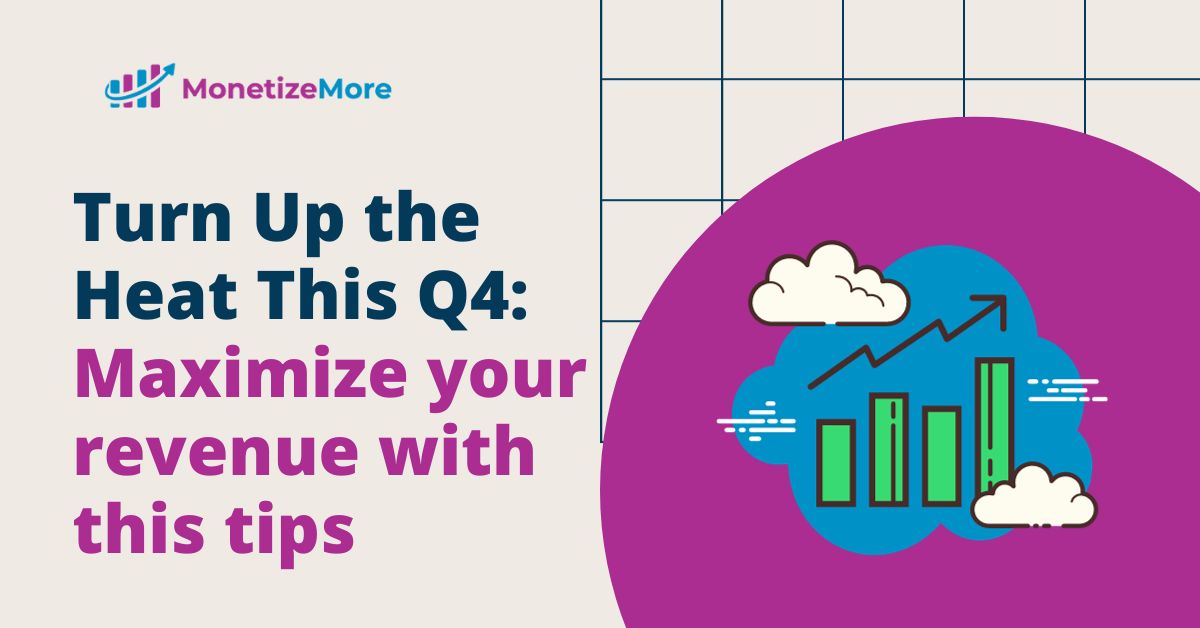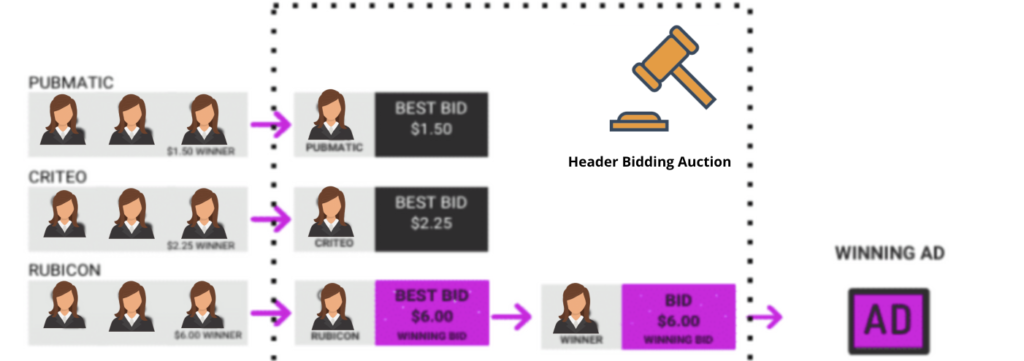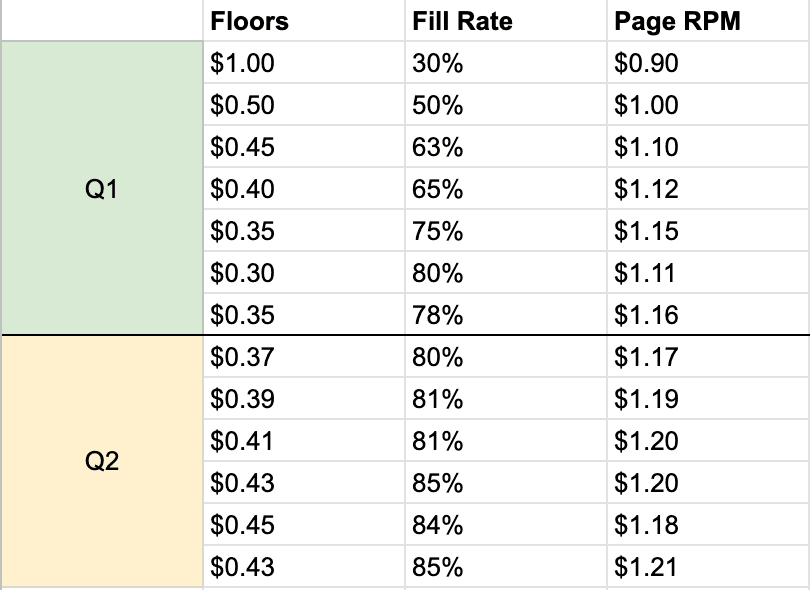
It’s Q4 already and you know what that means? It’s time to buckle up for the most lucrative quarter: Q4. The significance of Q4 lies in its unique blend of seasonal festivities. From Halloween to Hanukkah, Black Friday to Christmas, consumers are inundated with reasons to shop, celebrate, and most importantly, engage with content. Advertisers, recognizing this heightened consumer activity, ramp up their marketing efforts, vying for premium ad spaces and audiences. Consequently, ad demand skyrockets, driving up rates and making it a hotbed for revenue generation for publishers.
But it’s not just about the festive boom. As businesses wrap up their fiscal year, there’s often a ‘use it or lose it’ attitude towards marketing budgets. Many companies, eager to exhaust their allocated funds, will invest heavily in advertising, even if it’s just to ensure they’re allocated a similar or higher budget the following year. This rush adds another layer of demand, further elevating Q4’s importance for publishers.
In essence, Q4 is to publishers what Black Friday is to retailers—a pivotal period that can significantly shape the annual bottom line. Recognizing its weight and approaching it with strategy and foresight is paramount for any publisher aiming to end the year on a high note. So in this article, we break down the best revenue optimization tips that will help publishers double down and increase revenue in Q4.
Let’s get started.
Q4 is often regarded as the crowning jewel in terms of revenue generation. With major festivals and shopping events like Halloween, Thanksgiving, Black Friday, Cyber Monday, Christmas, and New Year, consumers are more active, more receptive, and more inclined to make purchases. This heightened consumer activity translates directly into increased advertiser competition for prime ad slots, driving up the demand and, subsequently, the Cost Per Mille (CPM) rates.
Furthermore, Q4 is also characterized by the closing of fiscal budgets. Many companies, especially those in the retail sector, amplify their marketing and advertising efforts during this period, eager to utilize their annual budgets to the fullest. This ‘use it or lose it’ approach sees many businesses significantly increasing their overall ad spend, hoping to capture as much of the Q4 consumer activity as possible. For publishers, this means that not only is there an uptick in ad demand but also a willingness from advertisers to pay premium prices for quality placements.
Here’s what Kean Graham, MonetizeMore’s CEO has to share on Navigating Q4’s Potential:
Remember, Q4 is a marathon, not a sprint. Continuous monitoring and optimization are key to making the most of this lucrative period.
| Holiday/Festival | How you can maximize Ad Revenue with MonetizeMore? |
|---|---|
| Halloween | Utilize our data analytics to target costume and candy-themed ads for higher engagement. |
| Veterans Day (U.S.) | Leverage patriotic creatives and tap into sentiment with our optimized ad placements. |
| Black Friday | Deploy our real-time bidding strategies to capture peak shopper traffic. |
| Cyber Monday | Enhance mobile ad performance using our mobile-optimized solutions. |
| Thanksgiving (U.S.) | Maximize family and travel-themed ad placements with our audience segmentation tools. |
| Hanukkah | Implement our cultural targeting features for ads resonating with Jewish traditions. |
| Christmas | Leverage our AI-driven ad formats to highlight gifting and festive sales. |
| New Year’s Eve | Optimize party and event-themed ads with our dynamic floor pricing to capitalize on celebrations. |
These tailored tips ensure that with MonetizeMore’s expertise, publishers can make the most of each unique Q4 holiday and festival, driving unparalleled ad revenue.
eCPM refers to “effective Cost Per Mile”. In online advertising, eCPM is the ad revenue generated per 1000 impressions. With eCPM, publishers can calculate the ad revenue generated by an ad unit. A high eCPM means the publisher will see increased revenue and make more profit.
To calculate eCPM, use the formula:
CPM is the price advertisers set for 1000 ad impressions. On the other hand, eCPM is used by publishers to find out how much revenue they will earn per 1000 ad impressions.
Calculating eCPM is very important for publishers who want to significantly increase revenue in Q4.
Here are two key reasons why should you calculate it:
For instance, if an Ad Exchange paid you $10,000 for 1.6 million impressions, for a 336 x 280 ad unit and $40,000 for 4.2 million impressions, for a 160 x 600 ad unit, it would be difficult to directly compare both of them. But, if you use the eCPM formula, you will know that you earned $6.3 per thousand impressions for the 336 x 280 ad unit and $9.5 per thousand impressions for the 160 x 600 ad unit.
With the eCPM calculation, you can create and plan your ad units appropriately.
Here are some tips to help you boost your eCPM numbers:
Ad networks are companies that aggregate ad supply from publishers and match it with advertisers’ demand. As a publisher, it’s important that you work with the right ad network.
Why?
To increase your revenue, you need to ensure that relevant ads are shown to your site visitors. Sure, there are a lot of ad networks you can choose from but it’s best you choose the one that’s the right fit for you. Don’t choose an ad network because of the unique capabilities they offer.
For instance, if you run a niche website, you should work with a vertical ad network because they focus on delivering advertising to a specific (niche) audience. So, choose an ad network that fits your website requirements.
There are several articles online on the best ad formats to use. But the reality is that it’s not one size fits all. The ad formats that work for other websites might not work for you. So if you want to boost your eCPM, you need to do your own experiments.
Here are some of the commonly used ad formats:
Banner ads: These are permanent square-shaped or rectangular ad formats. Banner ads are the most popular ad formats. The problem is that there are a lot of banner ad formats to choose from.
How can you know the best to use on your website?
The best practice is to choose the one with the highest fill rate. Also, avoid the banner ads that are targeted by fraudsters. A study from Pixalate and OpenX found that found 11% of the traffic coming from video banner ads that are 300×250 pixels is bot-driven. The study also showed that this ad unit type had 31% higher ad fraud than other ad units sold via OpenX.
💡 If you use a solution like Traffic Cop, you will be able to easily identify and block ad fraud. Traffic Cop will keep your ad inventory safe from fraudsters and ensure your ad revenue is protected. Try Traffic Cop
So as much as possible, do your research before choosing the ad sizes on your website.
Interstitial ads: These ads have the highest eCPM rates because they are full-page ads. Interstitial ads occupy the entire screen of the viewer’s device. Although this ad format has a high eCPM, consider the viewer’s user experience before using it. The best time to use this ad format is between content so that it appears at natural app transition points.
Video ads: This ad format can appear in two ways.
Video ad formats are increasing in popularity these days. Just experiment to find the best format for your site.

Let’s dive into some innovative strategies publishers can implement with header bidding this Q4:
1. Expand Your Demand Partners: If you’ve been working with a limited set of demand partners, now’s the time to branch out. Integrating with emerging or niche demand partners can tap into unique advertiser bases, increasing competition and, therefore, your potential revenue.
2. Utilize Multi-format Bidding: Don’t limit header bidding to just display ads. Expand into video, native, or even in-app header bidding if applicable. Each format can unlock new demand sources and boost CPMs.
3. Adopt Server-to-Server (S2S) Integrations: While traditional client-side header bidding has its merits, S2S offers reduced latency and the ability to integrate with more partners without compromising user experience. It can also offer better cookie match rates with certain partners, improving user targeting and ad relevance.
4. Granular Price Floors: Instead of setting a universal price floor, consider segmenting them based on ad unit, device type, geographical location, or even time of day. This dynamic approach ensures you’re not undervaluing any inventory.
5. Implement Identity Solutions: With the decline of third-party cookies, identity solutions like Unified ID, LiveRamp, or ID5 offer ways to enhance user targeting. Integrating these into your header bidding setup can make your inventory more valuable to advertisers focused on precise targeting.
6. Embrace the Power of Machine Learning: There are solutions out there that use machine learning to optimize header bidding in real-time. Whether it’s adjusting floor prices, choosing the best demand partners, or predicting the best ad formats, AI-driven platforms can offer an edge.
7. Audit and Optimize Regularly: As Q4 progresses, continuously analyze your header bidding performance. Identify any bottlenecks or underperforming demand partners and make iterative changes. This dynamic approach ensures you’re consistently optimizing for peak performance.
8. Engage in Transparent Dealings: Highlight your commitment to ad quality, brand safety, and viewability. Advertisers are willing to pay a premium for placements they trust. Make sure you’re sharing relevant metrics with them and consider adopting tools and certifications that enhance transparency.
By leveraging these tips and staying agile, publishers can maximize their revenue potential with header bidding this Q4. Remember, it’s all about continuously adapting, testing, and refining your strategies in response to the ever-changing digital ad ecosystem.

As we approach Q4, the AdTech arena witnesses a surge in demand, primarily fueled by the holiday season, festive sales, and year-end campaigns. Advertisers aggressively compete for premium ad slots, aiming to capture the heightened consumer activity. Here’s where Dynamic Floor Pricing (DFP) can be a game-changer for publishers.
What is Dynamic Floor Pricing? Unlike static floor pricing, where a fixed minimum price is set for ad inventory, Dynamic Floor Pricing automatically adjusts the minimum acceptable bid based on real-time market conditions. This dynamic mechanism takes into account factors like historical bid data, time of day, type of content, user behavior, and even granular aspects like geographical location.
Advantages of Dynamic pricing in Q4:
To harness Q4’s increased demand, optimizing ad placements is crucial. Here’s how publishers can refine their ad placements in Q4 to maximize revenue:
1. Understand Your Audience Behavior:
2. Optimize Ad Sizes & Formats:
3. Consider Viewability:
4. A/B Testing:
5. Diversify Ad Placements:
6. Prioritize Mobile Optimization:
As the Google algorithm constantly evolves, websites that are not mobile-friendly will lose a lot of their organic traffic. This will result in fewer impressions on your ads and a lower eCPM. So if you want to increase your revenue, ensure that your website is mobile-friendly.
Some simple tips to make your website mobile-friendly include:
When your website is mobile-friendly and offers a high ad engagement, advertisers will want to bid on your website for more impressions.
Q4, with its marathon of festivities and heightened consumer activity, can be a double-edged sword for advertisers. While it presents a golden opportunity to engage with a receptive audience, there’s also the lurking danger of ‘ad fatigue’. Ad fatigue occurs when the audience becomes overly familiar with an ad’s messaging and imagery, leading to diminished engagement, reduced click-through rates, and even potential brand disinterest. As AdTech pioneers, We’ve seen firsthand how this can erode the return on advertising spend (ROAS) and dampen the seasonal euphoria.
To combat this, two strategies emerge as frontrunners: Rotation and Diversification. Rotation is the practice of regularly switching out ad creatives, ensuring that the audience always encounters fresh messaging and imagery. Especially in Q4, when consumers are bombarded with ads, having a rotating roster of creatives can maintain engagement levels. This is even more crucial for long-standing campaigns that span multiple holidays within Q4.
On the other hand, Diversification focuses on tailoring ad creatives to resonate with specific holidays. Instead of a generic festive ad, create separate, unique ads for Halloween, Thanksgiving, Black Friday, Hanukkah, Christmas, and New Year’s. This not only ensures relevancy but also capitalizes on the unique sentiments and purchasing behaviors associated with each holiday.
To truly maximize your advertising potential, you need comprehensive AdTech solutions tailored to your unique needs. MonetizeMore, with its industry-leading expertise and cutting-edge technologies, is perfectly positioned to help you navigate these complexities. Whether you’re a publisher aiming for optimal ad placements or an advertiser seeking the best engagement strategies, our solutions are designed to deliver unparalleled results.

With over seven years at the forefront of programmatic advertising, Aleesha is a renowned Ad-Tech expert, blending innovative strategies with cutting-edge technology. Her insights have reshaped programmatic advertising, leading to groundbreaking campaigns and 10X ROI increases for publishers and global brands. She believes in setting new standards in dynamic ad targeting and optimization.

Paid to Publishers
Ad Requests Monthly
Happy Publishers
10X your ad revenue with our award-winning solutions.